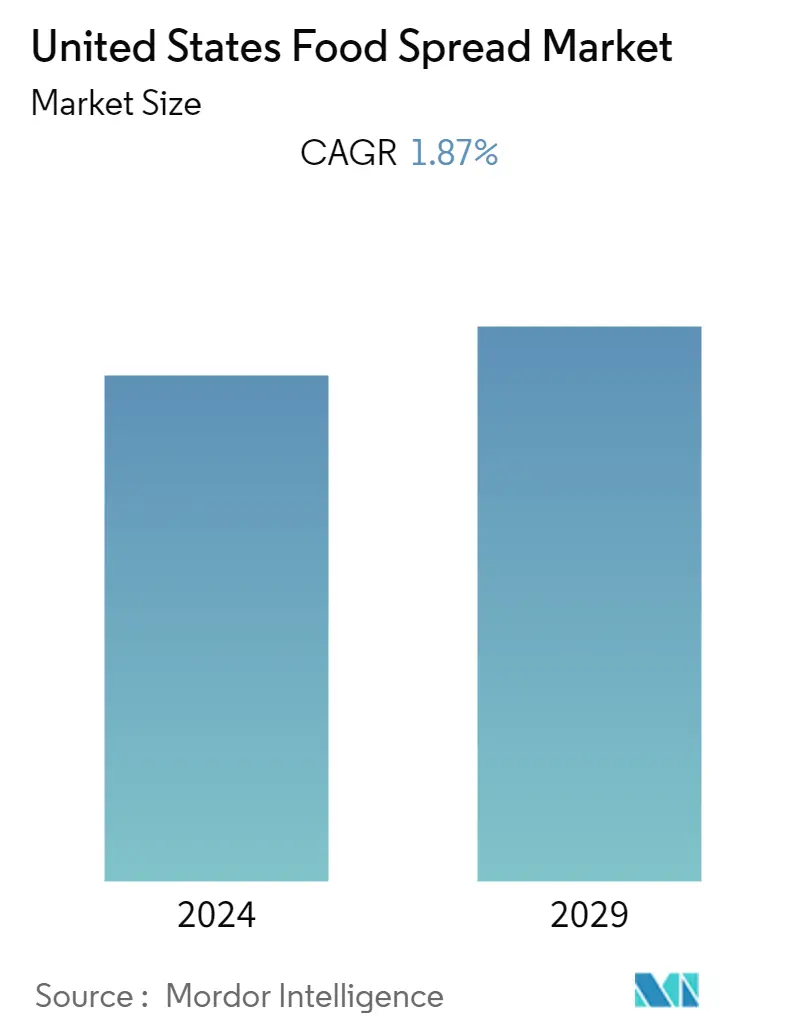Market Size of United States Food Spread Industry

| Study Period | 2019 - 2029 |
| Base Year For Estimation | 2023 |
| Forecast Data Period | 2024 - 2029 |
| Historical Data Period | 2019 - 2022 |
| CAGR | 1.87 % |
| Market Concentration | Low |
Major Players.webp)
*Disclaimer: Major Players sorted in no particular order |
US Food Spread Market Analysis
The US Food Spread Market is projected to witness a CAGR of 7.87% over the next five years.
The growing customer demand to substitute healthier spreads like peanut-based spreads for jam or butter is driving food spreads in the United States. Additionally, spreads like peanut flavored have become the most popular item and are widely used in the region due to their lower cost compared to substitutes like almond-based spreads. Jams and other substitutes may have some advantages, but they include a lot of sugar, which may lead to weight gain, cavities, heart disease, and type 2 diabetes. Thus, the market has also been driven for a few years by customers' growing health consciousness. For instance, according to the Harris poll report, last year, around 15% of adults in the United States reported having at least two chronic medical conditions, while only around 11% of older millennials reported the same. Also, around 11%, 7%, 5%, and 3% of people in the United States are suffering from mental health, cancer, obesity, and diabetes this year, according to the survey conducted by Research! America.
Additionally, consumers are concentrating on low-calorie diets due to the prevalence of lifestyle-related disorders. From 2020 to 2050, the percentage of health spending in the United States devoted to overweight and related disorders is expected to reach 14%, according to the Organization for Economic Co-Operation and Development (OECD) research. Additionally, governments have implemented policies to limit sugar intake, including front-of-package warning labels, which are anticipated to encourage the adoption of low-calorie items like nut spreads in the country.
US Food Spread Industry Segmentation
A spread is a food that is spread, generally with a knife, onto foods such as bread and crackers. Spreads are added to food to enhance the flavor or texture of the food.
The US Food Spread Market is segmented by Product Type (Nut- and Seed-based Spread, Fruit-based Spread, Honey, Chocolate-based Spread, and Other Product Types) and Distribution Channel (Supermarkets/Hypermarkets, Convenience Stores, Specialist Retailers, Online Retail Stores, and Other Distribution Channels). The market sizing has been done in value terms in USD for all the abovementioned segments.
| Product Type | |
| Nut- and Seed-based Spread | |
| Fruit-based Spread | |
| Honey | |
| Chocolate-based Spread | |
| Others |
| Distribution Channel | |
| Supermarkets/Hypermarkets | |
| Convenience Stores | |
| Specialist Retailers | |
| Online Retail Stores | |
| Other Distribution Channels |
United States Food Spread Market Size Summary
The US food spread market is experiencing significant growth, driven by a shift in consumer preferences towards healthier options such as nut-based spreads. This trend is largely influenced by increasing health consciousness among consumers, who are seeking alternatives to traditional spreads like jams and butters that are high in sugar and associated with various health issues. The popularity of peanut-based spreads, in particular, is rising due to their cost-effectiveness and nutritional benefits, such as being a good source of fiber and protein. The market is also benefiting from government initiatives aimed at reducing sugar intake and promoting low-calorie diets, which align with the broader consumer movement towards nutritious and plant-based foods.
The demand for plant-based and vegan spreads is further propelling market growth, as consumers become more aware of the health and ethical implications of dairy consumption. The US market is well-established in nut-based spread production, with major players like The J.M. Smucker Company, Ferrero International, and Unilever PLC leading the charge. These companies are innovating and expanding their product offerings to meet the growing demand for natural and organic options. The market's expansion is supported by trends such as sugar reduction, increased protein and fiber intake, and a preference for high-quality, additive-free products. As a result, the nut-based spread market is poised for continued growth, with a focus on catering to health-conscious and environmentally aware consumers.
United States Food Spread Market Size - Table of Contents
-
1. MARKET DYNAMICS
-
1.1 Market Drivers
-
1.2 Market Restraints
-
1.3 Porter's Five Forces Analysis
-
1.3.1 Threat of New Entrants
-
1.3.2 Bargaining Power of Buyers/Consumers
-
1.3.3 Bargaining Power of Suppliers
-
1.3.4 Threat of Substitute Products
-
1.3.5 Intensity of Competitive Rivalry
-
-
-
2. MARKET SEGMENTATION
-
2.1 Product Type
-
2.1.1 Nut- and Seed-based Spread
-
2.1.2 Fruit-based Spread
-
2.1.3 Honey
-
2.1.4 Chocolate-based Spread
-
2.1.5 Others
-
-
2.2 Distribution Channel
-
2.2.1 Supermarkets/Hypermarkets
-
2.2.2 Convenience Stores
-
2.2.3 Specialist Retailers
-
2.2.4 Online Retail Stores
-
2.2.5 Other Distribution Channels
-
-
United States Food Spread Market Size FAQs
What is the current United States Food Spread Market size?
The United States Food Spread Market is projected to register a CAGR of 1.87% during the forecast period (2024-2029)
Who are the key players in United States Food Spread Market?
The J.M. Smucker Company, Sioux Honey Association Co-op, Unilever PLC, Ferrero International S.A. and Conagra Brands Inc. are the major companies operating in the United States Food Spread Market.

